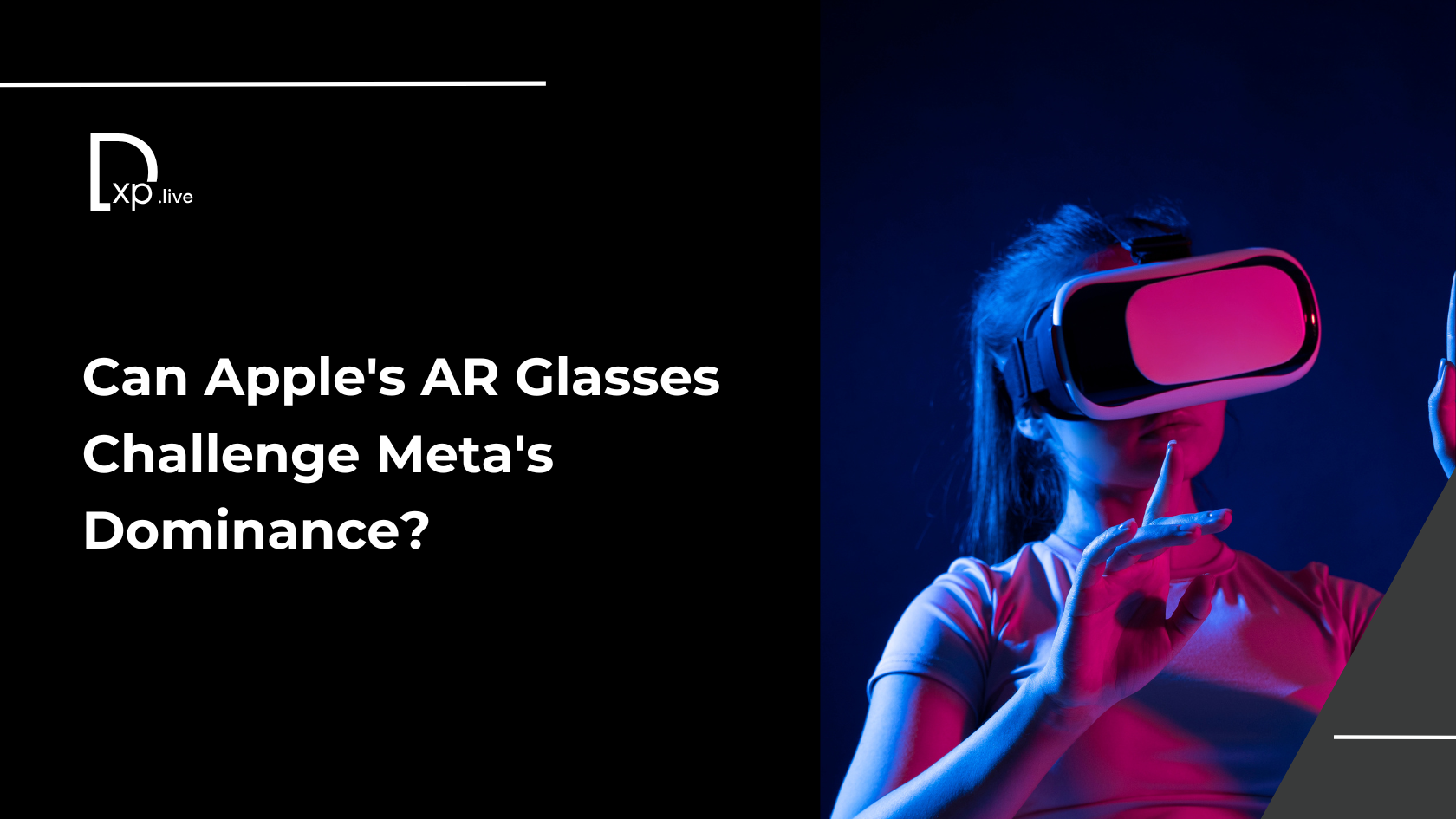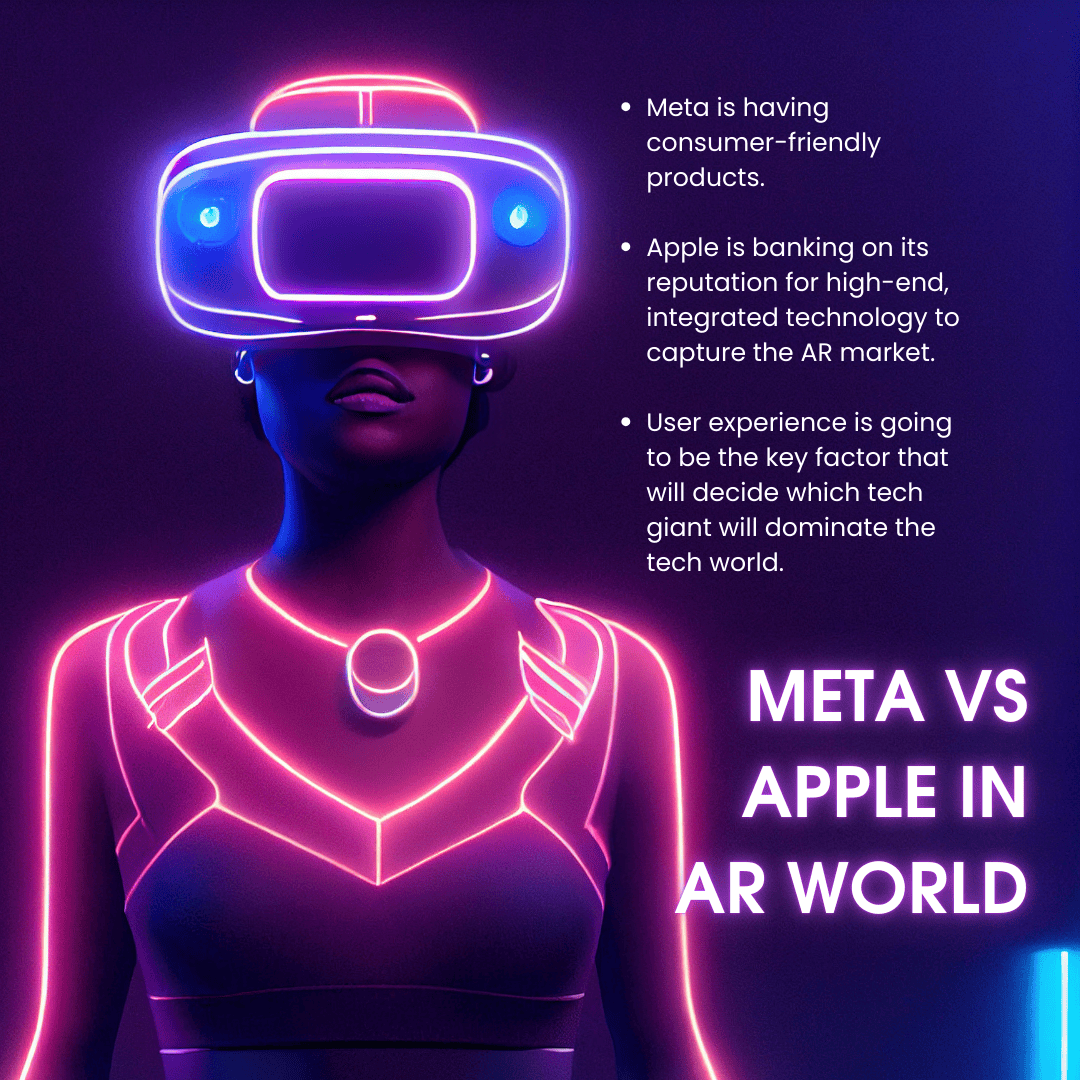Can Apple's AR Glasses Challenge Meta's Dominance?

Apple’s dominance in the tech space is undeniable. From smartphones to wearables, the company has set trends and redefined industries. Now, Apple’s latest ambition seems clear: to disrupt Meta’s growing foothold in the augmented reality (AR) market. With the rumored launch of AR glasses and innovative AirPods by 2027, Apple aims to challenge Meta’s reign in a tech frontier that has just started to gain momentum. But can Apple’s high-tech offerings truly compete with Meta’s more accessible, consumer-friendly solutions?

The Vision Pro by Apple
The Vision Pro, which was Apple's first venture into mixed reality, attracted a lot of attention due to its bleeding-edge technology but retailed for $3,500. It has certainly fascinated the early adopter crowd and the tech zealots, but it did not exactly fire the imagination of the mainstream in large numbers, mainly because of its high cost. For most people, it is just another space-age gadget that is more appealing than practical, at least for now.
While Apple's strategy seems to be that of learning from this first product and applying the innovations it has developed for Vision Pro into the next products, the technology giant is working on a more affordable Vision headset reportedly priced at around $ 2,000. Cutting off material costs and eliminating features like EyeSight should make this technology much more accessible to users, thus expanding its base.
But does that incremental price drop make AR and VR more attractive to the average consumer, or is Apple still underestimating the price sensitivity of the market?
Apple To Catch Up with Meta
Meta, through its partnership with Ray-Ban, has been quietly building its AR empire. With a lightweight design and an affordable price tag of $299, the Meta Ray-Ban Smart Glasses have already positioned themselves as a consumer-friendly option. Meta has also been busy with its Orion Smart Glasses, further solidifying its stance in the AR space. The tech giant has effectively captured early adopters by offering practical and relatively inexpensive products—a strategy that Apple has traditionally shied away from.
Apple’s strengths lie in creating an integrated ecosystem where all devices work seamlessly together, and its AR glasses will likely follow suit. But with the AR market still being relatively niche, Apple’s late entry might be a gamble. In contrast, Meta’s strategy seems more focused on making AR glasses an everyday accessory, much like smartphones.
Another exciting prospect from Apple’s roadmap is the development of AirPods with built-in cameras. While the idea of earbuds that can visually scan the surroundings may sound futuristic, it begs the question—who exactly needs this feature?
Some experts speculate that these AirPods will be designed to work in tandem with Apple’s AR glasses, enhancing user interaction by tracking hand gestures or delivering spatial audio that adapts to the wearer’s environment. While these features certainly sound innovative, the real test will be how they translate into everyday utility.
How User Experience Will Be Apple’s Key to Beat Meta
When it comes to user experience (UX), Apple has always been a market leader, known for its seamless ecosystem and intuitive designs. In the battle for augmented reality (AR) dominance, Apple’s focus on delivering a superior user experience could be the key factor that sets it apart from Meta.
While Meta has made AR more accessible through its Ray-Ban Smart Glasses and other affordable products, Apple is looking to take user experience to the next level by deeply integrating AR into its already expansive ecosystem. With its upcoming AR glasses, Apple aims to leverage the technology developed for the Vision Pro, promising not only impressive hardware but also a level of software integration that Meta may struggle to match.
Apple’s strength lies in creating an interconnected experience across all its devices. Imagine the AR glasses syncing seamlessly with your iPhone, MacBook, and Apple Watch, offering a cohesive experience that feels like an extension of your existing devices. For instance, features like gesture control, powered by AirPods with built-in cameras, and spatial audio that adapts to your surroundings, would provide users with a multi-sensory, immersive experience. This deep integration of hardware and software is an area where Apple excels and where Meta could lag.
Furthermore, Apple’s emphasis on privacy and security will likely resonate with users. While Meta has faced criticism over data privacy issues, Apple’s commitment to safeguarding user data could become a strong differentiator in the AR space. By ensuring that users feel safe while engaging with AR, Apple is poised to offer an experience that isn’t just innovative, but also trusted by its user base.
In the end, while Meta has focused on making AR more affordable and accessible, Apple’s strategic focus on delivering a polished, premium user experience could help it win over a different segment of the market—those who value seamless integration, intuitive use, and privacy. This dedication to UX may ultimately be the deciding factor in whether Apple can dethrone Meta in the AR race.
The Race to Lead the AR Space
As Apple and Meta gear up for a head-to-head battle in the AR glasses market, there’s no doubt that 2027 will be a pivotal year for both companies. Meta has already built a strong foundation with affordable, user-friendly products, while Apple is banking on its reputation for high-end, integrated technology to capture the AR market.
What Apple does have in its favor is its ecosystem. If Apple’s AR glasses and camera-equipped AirPods can work seamlessly with its other devices like the iPhone, iPad, and MacBook, it could create an unparalleled user experience that Meta may struggle to replicate. Apple has always excelled in creating a ‘halo effect’ where owning one product compels consumers to buy others within the same ecosystem. This could be a game-changer for the AR market if executed well.
Meta, on the other hand, is already a couple of steps ahead in terms of AR adoption. By the time Apple’s glasses launch in 2027, Meta will likely have rolled out several iterations of its Ray-Ban Smart Glasses and Orion models. This head start gives Meta ample time to improve its technology, refine its user experience, and, most importantly, build brand loyalty among AR users. It will be fascinating to see whether Apple’s late entry will pay off or if Meta’s early dominance will prove too difficult to overcome.
Future Ahead
As we move closer to 2027, the augmented reality space is shaping up to be a battleground between two tech giants with very different approaches. Apple’s focus on high-tech, integrated solutions versus Meta’s emphasis on affordability and practicality creates an intriguing dynamic. While Apple’s AR glasses and camera-equipped AirPods have the potential to revolutionize the industry, they face stiff competition from Meta, which has already laid the groundwork for a more accessible AR experience.
Curious about how AR technology could impact your business strategy?
At digitalexperience.live, we bring you expert insights and in-depth analysis of the latest trends in AR, VR, and beyond. Don’t miss out—subscribe to our news today to explore how AR can revolutionize your business!
FAQs
1. What are AR glasses?
AR (Augmented Reality) glasses overlay digital information in the real world, enhancing the user's environment with virtual elements.
2. How does Apple’s Vision Pro compare to Meta’s AR glasses?
Apple’s Vision Pro is a high-end, mixed-reality headset with a $3,500 price tag, whereas Meta’s AR glasses are more consumer-friendly, focusing on affordability and practicality.
3. Will Apple’s AR glasses be able to compete with Meta’s products?
Apple’s AR glasses will likely offer more advanced technology, but Meta’s head start with affordable options like Ray-Ban Smart Glasses may give them an early advantage.
4. What makes Apple’s AirPods with cameras different?
Apple’s rumored AirPods with cameras are expected to integrate with their AR glasses, using visual intelligence for gesture control and spatial audio features, unlike Meta's simpler camera-enabled devices.




